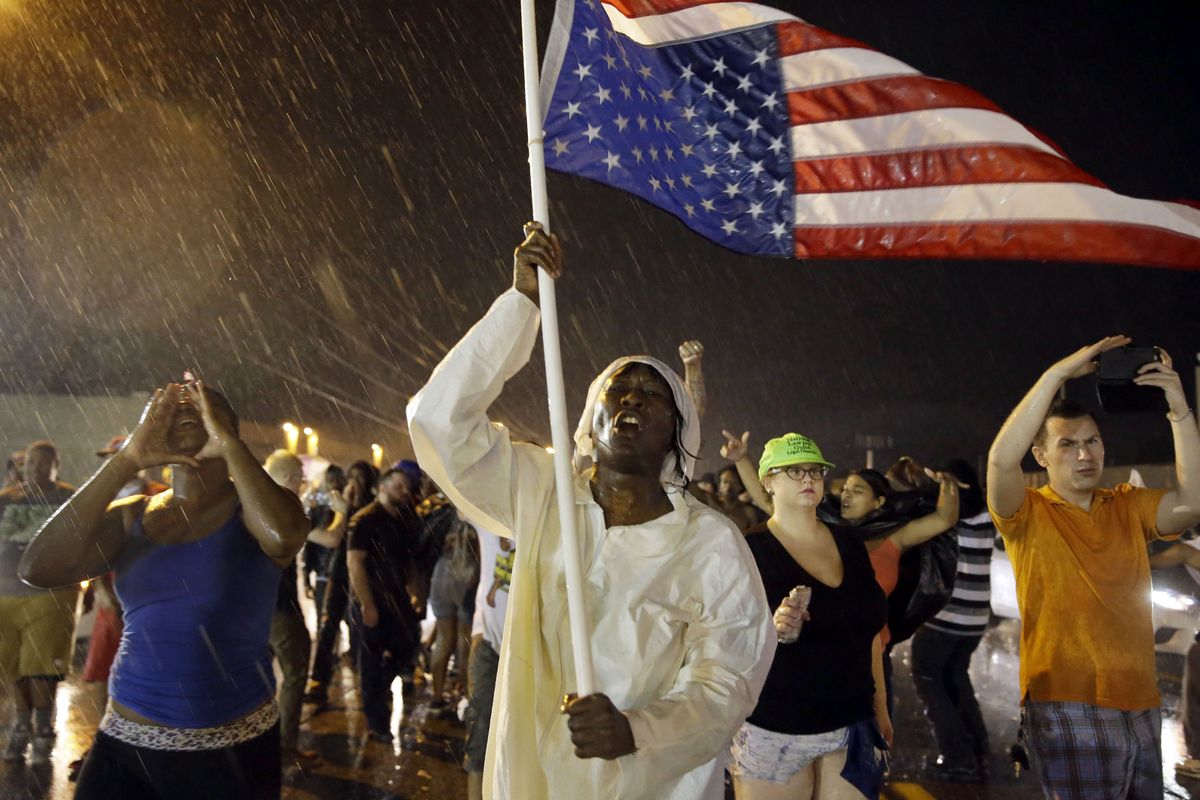Shots fired at Ferguson protest marking anniversary of Brown’s death

FERGUSON, Mo. – The anniversary of 18-year-old Michael Brown’s death in Ferguson began with a solemn march in his honor and ended with a rowdy protest that was interrupted by gunfire.
Shots rang out around 11:15 p.m. Sunday as several hundred people gathered on West Florissant Avenue.
St. Louis County police said in an emailed statement that an officer who came under “heavy gunfire” had returned shots.
It wasn’t immediately clear whether anyone was injured in the shooting, but minutes after the shots were heard, an Associated Press photographer saw a man lying face down, covered in blood, behind a boarded-up restaurant. It wasn’t immediately clear how badly the man was injured.
Later, an AP reporter saw a woman overcome with grief. Friends were consoling her. She screamed: “Why did they do it?” Another woman nearby fainted.
A man nearby said, “They killed my brother.”
The police department tweeted that at least two unmarked cars were hit by gunfire. A spokesman didn’t immediately respond to questions about the shooting.
Several events earlier Sunday marked the anniversary of the killing that cast greater scrutiny on how police interact with black communities. Brown’s father, Michael Brown Sr., led a march through town after a crowd of hundreds observed four and a half minutes of silence.
The group began their silence at 12:02 p.m., the time Brown was killed, for a length of time that symbolized the four-and-a-half hours that his body lay in the street after he was killed. Two doves were released at the end.
The elder Brown then held hands with others to lead the march, which started at the site where his son, who was black and unarmed, was fatally shot by Ferguson Officer Darren Wilson on Aug. 9, 2014. A grand jury and the U.S. Department of Justice declined to prosecute Wilson, who resigned in November, but the shooting touched off a national “Black Lives Matter” movement.
Pausing along the route at a permanent memorial for his son, Michael Brown Sr. said, “Miss you.”
He had thanked supporters before the march for not allowing what happened to his son to be “swept under the carpet.”
Later, a few hundred people turned out at Greater St. Mark Family Church for a service to remember Brown, with his father joining other relatives sitting behind the pulpit. Anthony Gray, a Brown family attorney pressing a wrongful-death lawsuit against Ferguson, Wilson and his former police chief, suggested that justice will be served on Michael Brown’s behalf.
Gray told the crowd: “You knew in your gut that (the shooting) wasn’t right. And you knew what that officer did was unjustified.”
The two-hour commemoration, featuring a mime dance and a rap-infused version of “Lean on Me” peppered between reflections about Brown, thinned as it wore on. Roughly 50 still remained by the time Michael Brown Sr. was finally handed the microphone to thank attendees and close out the event, saying, “This movement is going to be a good movement.”
The anniversary has sparked days of renewed protests, though until Sunday they had been peaceful and without any arrests.
Before the shots were fired, protesters were blocking traffic and confronting police. One person threw a glass bottle at officers but missed.
For the first time in three consecutive nights of protests, some officers were dressed in riot gear, including bullet-proof vests and helmets with shields.
Organizers of some of the weekend activities have pledged a day of civil disobedience today but have not offered specific details.
Earlier, at the march, some wore T-shirts with likenesses of Brown or messages such as “Please stop killing us” or “Hands up! Don’t shoot!” which became a rallying cry during the sometimes-violent protests that followed the shooting a year ago.
But the focus of the weekend has largely been on Brown, who graduated from high school weeks before the shooting and planned to go to trade school to study to become a heating and air-conditioning technician.
Relatives and friends described Brown as a quiet, gentle giant who stood around 6-foot-3, weighed nearly 300 pounds and was eager to start technical college. But police said Brown stole items from a convenience store and shoved the owner who tried to stop him on the morning of Aug. 9, 2014. Moments later, he and a friend were walking on Canfield Drive when Wilson, who is white, told them to move to the sidewalk.
That led to a confrontation inside Wilson’s police car. It spilled outside, and Wilson claimed that Brown came at him, menacingly, leading to the fatal shooting. Some witnesses claimed Brown had his hands up in surrender. Federal officials concluded there was no evidence to disprove testimony by Wilson that he feared for his safety, nor was there reliable evidence that Brown had his hands up in surrender when he was shot.
The shooting led to protests, some violent, and the unrest escalated again in November when a St. Louis County grand jury determined that Wilson did nothing wrong. He resigned days later. The November riots included fires that burned more than a dozen businesses.
The Justice Department reached the same conclusion in March, clearing Wilson. But in a separate report, the Justice Department cited racial bias and profiling in policing as well as a profit-driven municipal court system that often targeted black residents, who make up about two-thirds of Ferguson’s populace.
Ferguson’s city manager, police chief and municipal judge resigned within days of that report. All three were white. The new judge, interim city manager and interim police chief are all black.